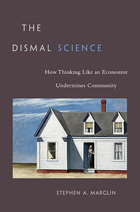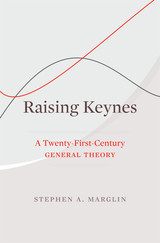

Economists celebrate the market as a device for regulating human interaction without acknowledging that their enthusiasm depends on a set of half-truths: that individuals are autonomous, self-interested, and rational calculators with unlimited wants and that the only community that matters is the nation-state. However, as Stephen A. Marglin argues, market relationships erode community. In the past, for example, when a farm family experienced a setback—say the barn burned down—neighbors pitched in. Now a farmer whose barn burns down turns, not to his neighbors, but to his insurance company. Insurance may be a more efficient way to organize resources than a community barn raising, but the deep social and human ties that are constitutive of community are weakened by the shift from reciprocity to market relations.
Marglin dissects the ways in which the foundational assumptions of economics justify a world in which individuals are isolated from one another and social connections are impoverished as people define themselves in terms of how much they can afford to consume. Over the last four centuries, this economic ideology has become the dominant ideology in much of the world. Marglin presents an account of how this happened and an argument for righting the imbalance in our lives that this ideology has fostered.

What determines the rate of growth, the distribution of income, and the structure of relative prices under capitalism? What, in short, makes capitalist economies tick? This watershed treatise analyzes the answers to these questions provided by three major theoretical traditions: neoclassical, neo-Marxian, and neo-Keynesian. Until now, the mutual criticism exchanged by partisans of the different traditions has focused disproportionately on the logical shortcomings of rival theories, or on such questions as whether or not input–output relationships can be described by a continuous-substitution production function.
In this book, these are at best secondary issues. The real distinguishing features of the theories, for Stephen Marglin, are their characterization of labor markets and capital accumulation. For clarity, Marglin first sets out the essential features of each theory in the context of a common production model with a single good and a fixed-coefficient technology. He then formalizes the different theories as alternative ways of closing the model. In subsequent chapters he examines the effects of relaxing key simplifying assumptions, in particular the characterization of technology and the homogeneity of output and capital. And although his primary emphasis is theoretical, he does not ignore the problem of empirically testing the theories. Finally, he synthesizes the insights of the neo-Marxian and neo-Keynesian models into a single model that transcends the shortcomings of each taken separately.
Marglin anticipates that partisans of the different traditions will agree on one point: each will allow that the book reveals the shortcomings of the other theories but will insist that it fails utterly to reflect the power and majesty of one’s own particular brand of truth. Growth, Distribution, and Prices will be controversial, but it will not be ignored.

Back to the future: a heterodox economist rewrites Keynes’s General Theory of Employment, Interest, and Money to serve as the basis for a macroeconomics for the twenty-first century.
John Maynard Keynes’s General Theory of Employment, Interest, and Money was the most influential economic idea of the twentieth century. But, argues Stephen Marglin, its radical implications were obscured by Keynes’s lack of the mathematical tools necessary to argue convincingly that the problem was the market itself, as distinct from myriad sources of friction around its margins.
Marglin fills in the theoretical gaps, revealing the deeper meaning of the General Theory. Drawing on eight decades of discussion and debate since the General Theory was published, as well as on his own research, Marglin substantiates Keynes’s intuition that there is no mechanism within a capitalist economy that ensures full employment. Even if deregulating the economy could make it more like the textbook ideal of perfect competition, this would not address the problem that Keynes identified: the potential inadequacy of aggregate demand.
Ordinary citizens have paid a steep price for the distortion of Keynes’s message. Fiscal policy has been relegated to emergencies like the Great Recession. Monetary policy has focused unduly on inflation. In both cases the underlying rationale is the false premise that in the long run at least the economy is self-regulating so that fiscal policy is unnecessary and inflation beyond a modest 2 percent serves no useful purpose.
Fleshing out Keynes’s intuition that the problem is not the warts on the body of capitalism but capitalism itself, Raising Keynes provides the foundation for a twenty-first-century macroeconomics that can both respond to crises and guide long-run policy.
READERS
Browse our collection.
PUBLISHERS
See BiblioVault's publisher services.
STUDENT SERVICES
Files for college accessibility offices.
UChicago Accessibility Resources
home | accessibility | search | about | contact us
BiblioVault ® 2001 - 2024
The University of Chicago Press









